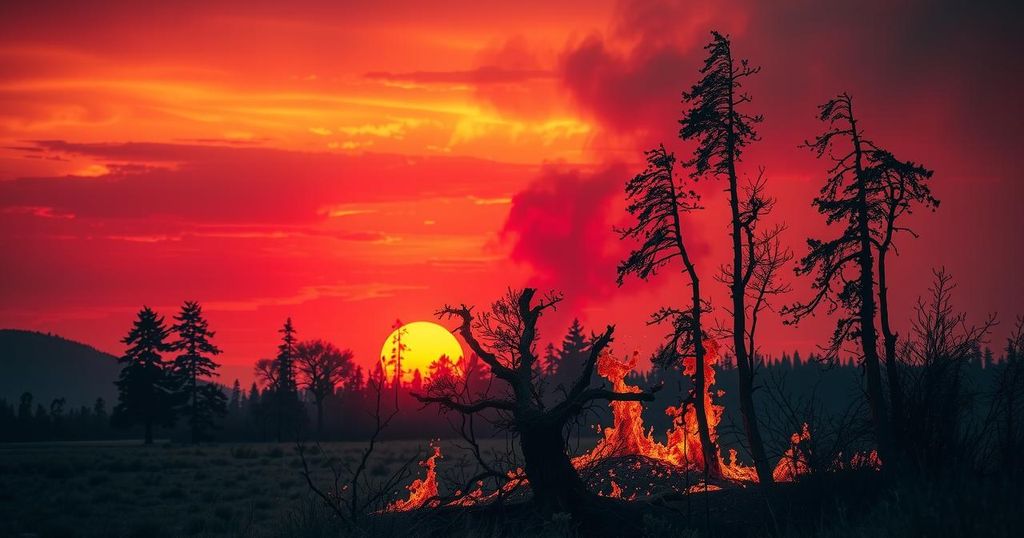The Impact of Santa Ana Winds on California’s Wildfires

Santa Ana winds are critical to California’s severe wildfires, exacerbated by climate change, requiring enhanced fire management strategies. These dry winds create highly flammable conditions and pose significant firefighting challenges. Technological advancements and a comprehensive approach blending climate adaptation and community education are necessary for future fire preparedness.
The Santa Ana winds, a critical meteorological phenomenon in Southern California, are a major contributor to the region’s catastrophic wildfires. These strong and dry winds exacerbate fire conditions, as evidenced by the recent Pacific Palisades fire, which stands as the most destructive wildfire in Los Angeles history. In light of climate change, the enhancement of these conditions necessitates advanced wildfire management and prevention strategies.
The mechanics behind the Santa Ana winds involve high-pressure systems that drive air from the interior region towards the coast. This movement creates intense heat and dryness, leading to relative humidity levels dropping below 10%, making vegetation extremely flammable. Gusts of wind can reach alarming speeds of up to 100 km/h, which not only helps to spread fires but also complicates firefighting efforts significantly.
Climate change plays a significant role in intensifying wildfire conditions, worsening the effects of the Santa Ana winds. Increasing temperatures, extended droughts, and diminished snow cover exacerbate the dryness of California’s landscape, rendering it more susceptible to fires. Since the mid-1990s, the area burned each summer has surged fivefold compared to previous decades, highlighting the critical need for effective fire management in a changing climate.
Historically, the Santa Ana winds have profoundly influenced Southern California’s landscape and fire occurrences, documented in Native traditions and European records. Major wildfires like the Bel Air Fire and Cedar Fire underscore the recurrent threat posed by these winds. Recognizing the relationship between these winds and fire severity emphasizes the importance of predicting and understanding their behavior for future preparedness.
The destructive capacity of the Santa Ana winds presents formidable challenges for firefighting efforts in California. The rapid spread of fires and complicated wind patterns hinder effective response and led to significant property loss during events like the Pacific Palisades fire, which resulted in the evacuation of thousands. Challenges such as traffic congestion and mass evacuations stress the need for enhanced emergency services and urban planning resilience.
Technological advancements are crucial in combating wildfires driven by Santa Ana winds. Drones with thermal imaging facilitate real-time insights into fire progression, while predictive AI models aid in resource allocation and early detection of fire threats. Integrating advanced meteorological data with satellite analysis enhances community readiness, marking a transformative shift in wildfire management strategies across California.
Addressing the challenges posed by Santa Ana winds requires a comprehensive approach that combines climate adaptation initiatives and community outreach. Strategies such as reforestation, proactive vegetation management, and fire-resistant urban planning are essential in minimizing risks. Collaborative efforts among scientists, urban planners, and firefighters will be essential to innovating technologies that can accurately forecast wind behavior, ultimately safeguarding lives and communities.
The Santa Ana winds are a meteorological phenomenon that significantly influences wildfire dynamics in Southern California. The winds result from high-pressure systems pushing dry air towards the coast, creating conditions conducive to fire spread. In conjunction with climate change, these winds have increasingly fueled devastating fires, prompting a need for sophisticated fire management techniques. Understanding their historical context and the interplay between climate change and these winds is vital for enhancing fire safety and resilience.
In summary, the Santa Ana winds present both historical and contemporary challenges regarding wildfire management in California. With the ongoing impacts of climate change, proactive measures, innovative technology, and cooperative strategies are essential to mitigate fire risks linked to these winds. A multidimensional approach encompassing climate adaptation, community engagement, and advanced monitoring will be central to protecting lives and properties in the future.
Original Source: www.drivingeco.com








